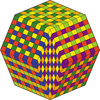issue contents
July 2022 issue

Cover illustration: The random conical tilt technique is used in single-particle cryo-electron microscopy to reconstruct the 3D molecular structure, but involves measuring pairs of images of the same field of view at different tilt angles. In this issue Ti-Yen Lan et al. [Acta Cryst. (2022). A78, 294–301] describe a new method which uses data collected at just one large tilt angle and circumvents the need for particle picking. The image shows the Fourier transforms of the molecular projections from pairs of micrographs collected at different tilt angles assembled in Fourier space with respect to their corresponding orientations (top, standard method) and the structure of myoglobin reconstructed using the new method from noisy micrographs at just one tilt angle (bottom right). The `ground truth' used to simulate the micrographs is shown at the bottom left.
advances
research papers
short communications
foundations
research papers
 access
accessobituaries



 journal menu
journal menu





























